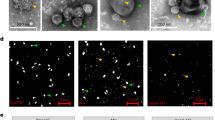Abstract
The development cycle of the cyanophage AS-1 was studied in the host blue-green alga, Anacystis nidulans, under conditions that impair photosynthesis and under various light/dark regimes. Under standard conditions of incubation the 16-h development cycle consisted of a 5-h eclipse period and an 8-h latent period. Burst size was decreased by dark incubation to 2% of that observed in the light. An inhibitor of photosystem II, 3-(3,4-dichlorophenyl)-1,1-dimethyl urea (DCMU), reduced the burst size to 27% of that of the uninhibited control, whereas cyanophage production was completely abolished by carbonyl-cyanide m-chlorophenyl hydrazone (CCCP), an inhibitor of photosynthetic electron transport. Dark incubation of infected cells decreased the latent period by 1–2 h and the eclipse period by 1 h, once the cultures were illuminated. This suggests that adsorption took place in the dark. Intracellular growth curves indicated that light is necessary for viral development. Infected cells must be illuminated at least 13 h to produce a complete burst at the same rate as the continuously illuminated control. Low light intensities retarded the development cycle, and at lowest light intensities no phage yield was obtained. AS-1 is highly dependent on host cell photophosphorylation for its development.
Similar content being viewed by others
Abbreviations
- CCCP:
-
Carbonyl-cyanide m-chlorophenyl hydrazone
- DCMU:
-
3-(3,4-dichlorophenyl)-1,1-dimethyl urea
- m.o.i.:
-
multiplicity of infection
- O.D.:
-
optical density
- PFU:
-
plaque-forming unit
References
Adolph, K. W., Haselkorn, R.: Photosynthesis and the development of blue-green algal virus N-1. Virology 47, 370–374 (1972)
MacKenzie, J. J., Haselkorn, R.: An electron microscope study of infection by the blue-green algal virus SM-1. Virology 49, 505–516 (1972a)
MacKenzie, J. J., Haselkorn, R.: Photosynthesis and the development of blue-green algal virus SM-1. Virology 49, 517–521 (1972b)
Padan, E., Ginsburg, D., Shilo, M.: The reproductive cycle of cyanophage LPP-1G in Plectonema boryanum and its dependence on photosynthetic and respiratory system. Virology 40, 514–521 (1970)
Padan, E., Shilo, M.: Cyanophages-viruses attacking blue-green algae. Bacteriol. Rev. 37, 343–370 (1973)
Pearson, N. J., Small, E. A., Allen, M. M.: Electron microscopic study of the infection of Anacystis nidulans by the cyanophage AS-1. Virology 65, 469–479 (1975)
Rippka, R.: Photoheterotrophy and chemoheterotrophy among unicellular blue-green algae. Arch. Mikrobiol. 87, 93–98 (1972)
Safferman, R. S., Diener, T. O., Desjardins, P. R., Morris, M. E.: Isolation and characterization of AS-1, a phycovirus infecting the blue-green algae, Anacystis nidulans and Synechococcus cedrorum. Virology 47, 105–113 (1972)
Sherman, L. A., Haselkorn, R.: LPP-1 infection of the blue-green algae Plectonema boryanum. I. Electron microscopy. J. Virol. 6, 820–823 (1970)
Sherman, L. A., Haselkorn, R.: Growth of the blue-green algae virus LPP-1 under conditions which impair photosynthesis. Virology 47, 739–746 (1971)
Author information
Authors and Affiliations
Additional information
Dedicated to Prof. Roger Y. Stanier on the occasion of his 60th birthday
Rights and permissions
About this article
Cite this article
Allen, M.M., Hutchison, F. Effect of some environmental factors on cyanophage AS-1 development in Anacystis nidulans . Arch. Microbiol. 110, 55–60 (1976). https://doi.org/10.1007/BF00416969
Received:
Issue Date:
DOI: https://doi.org/10.1007/BF00416969




